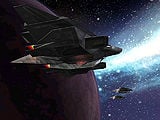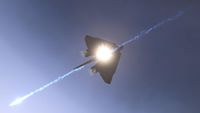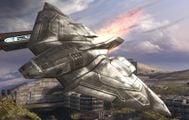GA-TL1 Longsword: Difference between revisions
From Halopedia, the Halo wiki
(→Trivia) |
No edit summary |
||
| Line 67: | Line 67: | ||
In the first ''[[Halo Trilogy|Halo]]'' game, ''[[Halo: Combat Evolved]]'', the inside of the ship presents a small corridor leading to the rear, a stair, and a higher corridor to the cockpit. In the two corridors, there are several equipment lockers, along with two secondary crew stations. The cockpit consists of two pilot chairs and two more auxiliary crew stations. With a known total crew complement of four, along with the equipment and weapon lockers, the ship presents itself as less of a fighter-bomber and more of a dedicated bomber and Close Support craft. | In the first ''[[Halo Trilogy|Halo]]'' game, ''[[Halo: Combat Evolved]]'', the inside of the ship presents a small corridor leading to the rear, a stair, and a higher corridor to the cockpit. In the two corridors, there are several equipment lockers, along with two secondary crew stations. The cockpit consists of two pilot chairs and two more auxiliary crew stations. With a known total crew complement of four, along with the equipment and weapon lockers, the ship presents itself as less of a fighter-bomber and more of a dedicated bomber and Close Support craft. | ||
If a life-sized construction of the Longsword were to be produced, its wingspan would be five meters longer than a Boeing 747, while its fuselage would be six meters shorter, making Longswords considerably larger than today's fighter aircraft, closer in size to bombers such as the similar B2 ''Spirit'' Stealth Bomber. | If a life-sized construction of the Longsword were to be produced, its wingspan would be five meters longer than a Boeing 747, while its fuselage would be six meters shorter, making Longswords considerably larger than today's fighter aircraft, closer in size to bombers such as the similar [B2 ''Spirit'' Stealth Bomber]. | ||
The cockpit design stayed the same between ''Halo'' and ''Halo 2'' but changed in ''Halo 3'', previously the cockpit had four windows (two on each side, but none in the front) and a view screen. In ''Halo 3'' the Longsword has windows wrapping around the cockpit like a traditional aircraft. | The cockpit design stayed the same between ''Halo'' and ''Halo 2'' but changed in ''Halo 3'', previously the cockpit had four windows (two on each side, but none in the front) and a view screen. In ''Halo 3'' the Longsword has windows wrapping around the cockpit like a traditional aircraft. | ||
Revision as of 21:55, June 30, 2009
- "...The ship's inventory shows one Longsword fighter still docked in Launch Bay 7. If we move now, we can make it!"
- — Cortana to John-117 during their escape from Installation 04
The C709 Longsword-Class Interceptor is the primary UNSC single ship, and a mainstay starfighter, filling a variety of roles simultaneously.
Role
Repeatedly described as a space fighter/interceptor, intended to engage enemy fighters, dropships, and boarding craft in route to their capital-ships, Longswords have also been seen in a variety of roles, making for an extremely versatile craft. It is relatively inexpensive to produce. They are capable of holding their own even against technologically superior fighters used by the Covenant, using missiles and cannons to deal tremendous firepower (without having much in the way of defenses) and with a skilled pilot may even be superior to the Covenant fighters, and escorting UNSC dropships as they deliver their passengers/various cargoes to planet surfaces or larger ships[1][2]. They are also used in attack runs against Covenant capital ships, delivering high-yield missiles[3], Shiva nuclear warheads[4], or even free-floating Moray space mines,[5] to or near their targets. Sometimes, they are used as bait, such as the case with Captain Wallace.[6] They can also be used in planetary environments by functioning as fighter-bombers, destroying ground targets from the air[7][8], escorting larger capital ships such as Frigates, Halcyon-class Cruisers, or Marathon-class Cruisers in their own assaults.
Structure
In the first Halo game, Halo: Combat Evolved, the inside of the ship presents a small corridor leading to the rear, a stair, and a higher corridor to the cockpit. In the two corridors, there are several equipment lockers, along with two secondary crew stations. The cockpit consists of two pilot chairs and two more auxiliary crew stations. With a known total crew complement of four, along with the equipment and weapon lockers, the ship presents itself as less of a fighter-bomber and more of a dedicated bomber and Close Support craft.
If a life-sized construction of the Longsword were to be produced, its wingspan would be five meters longer than a Boeing 747, while its fuselage would be six meters shorter, making Longswords considerably larger than today's fighter aircraft, closer in size to bombers such as the similar [B2 Spirit Stealth Bomber].
The cockpit design stayed the same between Halo and Halo 2 but changed in Halo 3, previously the cockpit had four windows (two on each side, but none in the front) and a view screen. In Halo 3 the Longsword has windows wrapping around the cockpit like a traditional aircraft.
Many changes occurred from Halo 2 to Halo 3 in the aesthetics of the ship. The first version in Halo: CE and Halo 2 had the diamond-shaped intakes which were removed for the Halo 3 version, so it can be proposed that the ship in Halo 3 is a different version of the Longsword. It may be noted, however, that all of the Longswords seen in Halo: Combat Evolved and Halo 2 are used in space combat, while those seen in Halo 3 are primarily used in an atmospheric fighter-bomber role.
Propulsion
There are two main engines discernible on a Longsword fighter. Their precise nature is not known, but they are able to function in space and they are strong enough to reach Earth's and Installation 04's escape velocity. The drive system cannot be purely chemical rocketry, as putting even a modest mass into orbit requires hundreds of tons of fuel. Likely, it is nuclear-powered, and the electrical energy or heat generated is used to power an electric drive or to heat regular fuel into a much higher impulse. There are multiple RCS points for maneuvering.
While escaping from Alpha Halo, the Master Chief's Longsword displayed a vertical-takeoff-and-landing (VTOL) capability, accelerating extremely quickly to atmospheric escape velocity, but nearly overheated the engines. Although this sudden overheat may be related to the problem that caused the Longsword to end up as being docked for maintenance and repair in the first place.
Weapons
The Longsword's main weapons are 110mm rotary cannons,[9] as well as 120mm ventral guns, for dog-fighting Seraph fighters in space and strafing ground targets when the need arises. This versatile fighter can be armed with an assortment of secondary weapons including ASGM-10 Missiles, bombs, Moray Space Mines, Scorpion Missiles, and can even heft a single Shiva Nuclear Warhead. The Longsword is usually deployed against Seraph fighters in space combat and Covenant artillery in planetary combat. It also may escort Pelicans as they head for the surface of a planet. It can also be remote piloted, carrying a single Shiva Nuclear Warhead, destroying the enemy ship and itself as well when the opportunity arises[10].
Trivia
- The Chief later captures a Covenant flagship by using a Longsword to get on board with the distraction of an unmanned Pelican carrying mines that took down the ship's Seraphs. Cortana took down the ship's shields and weapons, allowing the Longsword to land on board.
- The Longsword is one of the few UNSC vehicles that are not named or modeled after animals (Warthog, Hornet, etc.)
- Using saved films in Halo 3, Halo fans can get pictures of the Longsword in the levels "The Ark" (when the Longsword flies by and then crashes when the Master Chief finds the crashed Pelican and a surviving group of Marines) and in the level "The Storm" (when the Longsword is shot down by the Covenant Anti-Air gun). Although on The Storm, you won't be able to get a picture of the crash, since the Longsword disappears when it leaves the player's view.
- The Longsword fighter underwent many design iterations. [11]
- In Halo: Custom Edition, there are several maps that allow the player to pilot a Longsword. All mods include a large armament of Scorpion anti-tank missiles that auto-target within a wide, usually square like reticule, and reload once used up. It is also commonly armed with a high-powered bomb commonly called a "nuke" by players. This weapon emits a keening wail when dropped, has a tail of fire, falls to the ground with the force of gravity, and detonates with considerable force when it lands (enough force to destroy most vehicles, though some levels, such as Extinction, feature vehicles that can withstand this blast). Ironically, given its name, the weapon will leave behind a green glow on the surrounding area after detonation on some maps. It is given the physics of the Pelican Dropship from Halo: Combat Evolved. However it goes significantly faster than a Pelican, and therefore has a wider turning radius. While hovering, the Jump key will make the Longsword ascend, and the crouch key will make it descend.
- In canon, the pilot's seat is on the left, but most custom maps have right seat as the pilot's seat. Edited by an owner of Halo: CE, the pilot's seat is always on the left in Halo: CE.
- It is disputed whether the Longsword is black or gray, as it looks gray in the final level of Halo: Combat Evolved (The Maw), but when it is seen in space (and in Halo 3) it looks darker. This may be due to lighting or graphical enhancement.
- Longswords appear on The Storm and The Ark fighting space and in-atmosphere battles against Covenant fighters, along with fighting above the Ark.
- In Halo: First Strike four Longswords are used to cover a single Pelican. This, however, seems impractical due to how large the Longsword is compared to the Pelican. This is probably due to the importance of the Pelican's cargo.
- The Longsword is more than likely the successor of the Shortsword. However, this entered service around 8 years before the events of Halo Wars, when the Shortsword bomber was still in service, at least on the UNSC Spirit of Fire. As such, it is possible that they are two separate classes, or the Longsword was designed to supplement the Shortsword, which was designed as only a bomber aircraft.
- Based on the number of differences of the Longsword from Halo: Combat Evolved and Halo 2, compared to Halo 3 (such as cockpit design, different engine cowlings, smaller fin, lack of forward engines and appears to be smaller than the previous models) it is possible that the fighter seen in Halo 3 is a different model than the one seen in the earlier games.Template:Fact
- Longswords may or may not have working gravity. At the end of Halo: Combat Evolved, Spartan-117 got up out of his seat and walked over to the side screen to witness the destruction of Installation 04. However, in Halo: First Strike, it is said that the Spartan "floats" to the weapons locker at the back of the Longsword, and that when he picks up the remaining Marines, they too float about. However, this might be because the Longsword (or its artificial gravity) was powered down at the time.
- It is optional to have a Shiva nuclear missile aboard, although in Halo: First Strike, the Master Chief states, "We might get lucky if we find a couple of those Shiva nuclear-tipped missiles lying around.", which suggests it may be able to carry more than one missile.
- In Theater on the level The Ark, if you move to the scene of the crash before it happens, the Longsword is already there. The version that you see flying past actually mysteriously disappears, as the crash would have been too hard to produce for a scripted animation.
- In Halo: Custom Edition, the Longsword is depicted as having five different types of seats: the pilot, then the co-pilot (Which allows the pilot to do the driving and the co-pilot to do the shooting), the gunner seat (which serves the same position as a co-pilot, but the gunner seat allows the player to have a 360 view and can shoot at vehicles from behind) the support seat that appears in various parts of the body and lets the player simply ride (similar to to the cargo seat of the pelican) and a redundant seat, which is the exact same thing as a support seat; however, you are unable to shoot, and the player appears in the crouch position.
Known Longswords
Gallery
- Longsword-Specs.jpg
Longsword specs.
- LongswordBattle2.jpg
Longswords at the First Battle of Earth.
Three Longswords in the Second Battle of Earth.
- 20668469-Full.jpg
A Longsword flying overhead.
- Longsword flying.jpg
Longsword flying above Voi.
- HRS C709 Longsword front.jpg
A front-on view of the Longsword, demonstrating its thin horizontal profile.
- Longsword.png.png
Two longswords engaged in an upper atmospheric flight above earth.
Sources
- ^ Halo: First Strike, pg. 6
- ^ Halo 2, Cairo (Level)
- ^ Halo 2, Cairo
- ^ Halo: The Fall of Reach
- ^ Halo: First Strike, pg. 37
- ^ Halo: The Fall of Reach
- ^ Halo 2 E3 Demo
- ^ Halo 3, Floodgate
- ^ Halo: First Strike, page 28
- ^ Halo: The Fall of Reach
- ^ The Art of Halo
Related Links
Internal Liinks
- Seraph - The Covenant equivalent of the Longsword
- SkyHawk - the UNSC's dedicated atmospheric strike fighter.
- Tarasque-class heavy fighter - presumably a similar Covenant fighter.




